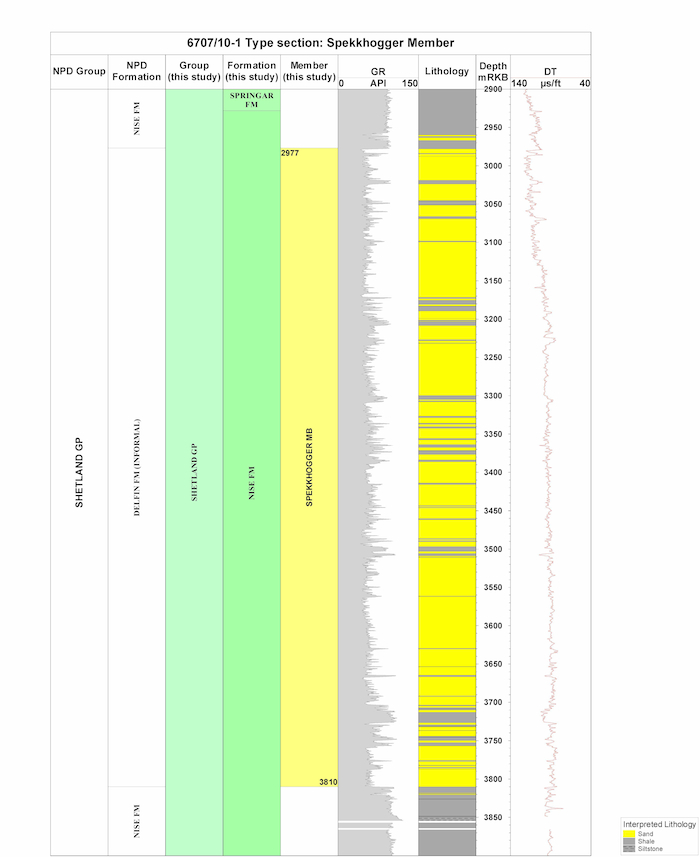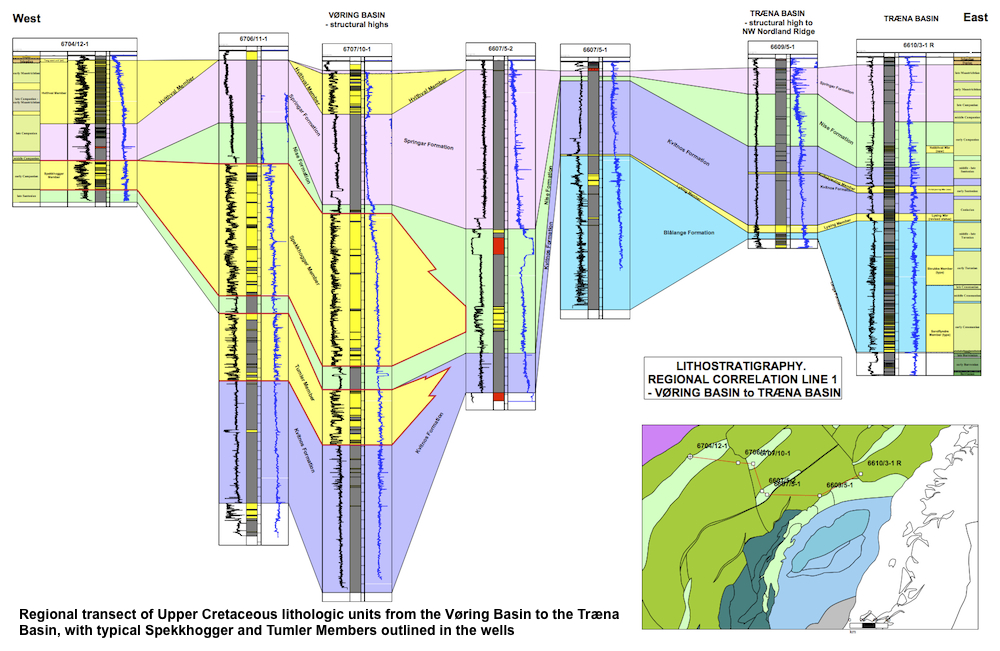 |
|
 |
|
updated to follow: Stratigraphic Guide to the Cromer Knoll, Shetland and Chalk Groups of the North Sea and Norwegian Sea. Felix M. Gradstein & Colin C. Waters (editors), Mike Charnock, Dirk Munsterman, Michelle Hollerbach, Harald Brunstad, Øyvind Hammer & Luis Vergara (contributors). Newsletter on Stratigraphy, vol 49/1 pp71-280, 2016
Shetland Group, Nise Formation
The Spekkhogger Member is a new member of the Nise Formation. It is a thick (over 800m) sandstone dominated succession of Late Cretaceous, early Campanian age developed in the Vøring Basin.
The Spekkhogger Member, together with the underlying Tumler Member were targeted by the first exploration well to be drilled in the deep water Vøring Basin, the Nyk High well 6707/10-1 (Kittilsen et al., 1999). Excellent quality sandstone reservoirs were recovered over 1000m thick, containing a 156m thick column of dry, thermogenic gas.
English/ Norwegian and any previous names:
In the type well 6707/10-1, the Spekkhogger Member was originally and correctly identified by the operator BP Norway as a sandstone unit within the Nise Formation. It is equivalent in part (together with the Tumler Member) to the informal ‘Utgard sandstone’ of Swiecicki et al. (1998), and the upper part (only) of the informal Delfin Formation on the fact pages of the NPD. The fact pages of NPD list two Delphin units separated by Nise Formation; this is not a correct form of lithostratigraphy and violates the stratigraphic code.
Derivatio nominis: Spekkhogger is the Norwegian name for the killer whale species Orcinus orca. This is appropriately the largest species of the oceanic dolphin family (Delphinidae) reaching up to 9m in length and 6-8 metric tons in weight. The species is widespread in the North Atlantic and can been seen along the Norwegian coast. The most famous individual being, of course, Keiko whose final home was in the bays off Halsa in Møre and Romsdal, mid Norway.
The Spekkhogger Member consists of thick sandstones with subordinate mudstone interbeds and rare dolomitic limestone stringers.
The sandstones are light to medium grey, light olive grey, brownish grey and pale yellow brown, transparent to translucent quartz grains, locally colourless to pale grey, rarely pale orange, very fine to medium, predominantly fine to medium, locally coarse, sub-angular to sub-rounded, occasionally sub-elongate to sub-sphaerical, moderate to well sorted, generally loose, occasionally firm, friable, weak silica or dolomitic/calcareous cement, locally argillaceous matrix, occasional kaolinitic matrix, silty, micaceous, occasionally disseminated pyrite, common to abundant glauconite, fine carbonaceous material, fair to good visible porosity.
The mudstones are medium light grey to dark olive grey, with occasional black streaks and speckles, soft to firm, amorphous to sub-blocky, plastic to crumbly, slightly silty in places or fine sand, trace disseminated pyrite, micro-carbonaceous, micro-micaceous, occasionally glauconitic, non-calcareous or slightly dolomitic in part.
The rare dolomitic limestone stringers are buff to off white or light grey-light yellow, soft to firm, occasionally hard to very hard, sub-blocky to blocky, crumbly to angular, occasionally glauconitic, occasionally grading to sandy limestones, microcrystalline.
Sandstones of the Campanian Spekkhogger Member are geographically restricted to the Vøring Basin based on released well data. The depositional centre axis is close to the Nyk High well 6707/10-1, where the unit attains an enormous 833m thickness. The Spekkhogger Member decreases significantly in thickness both to the west e.g. in well 6704/12-1 (321.5m) and south-east e.g. in well 6607/5-2 (140m), away from the main depositional fairway (Transect Figure 3.33).
Vergara et al. (2001) inferred that sandstones in their equivalent K85 -K90 sequence covered a large area of the (northern) Vøring Basin based on seismic interpretation and favoured a source from the north and north-east. Morton and Grant (1988) proposed a source from the north or north-west based on provenance studies on sandstones from the Utgard High well.
Time equivalent mudstones of the Nise Formation are developed in well 6605/8-1 and define a southerly limit of the member based on the available well coverage.
The seemingly two-fold division of the Spekkhogger Member in the 6607/5-2 maybe due to sand injection, associated with a volcanic intrusion ?
Reference well 6704/12-1: 5 slides from sidewall core samples covering the interval 3698m – 3904m available at the NPD (RRI preparations).
Type well 6707/10-1: core#1 to core #9: 2967mMD RKB – 3145mMD RKB
Reference well 6704/12-1: no core taken in this member.
Well name: 6707/10-1
WGS84 coordinates: N 67°04'07.85, E 07°00'36.51 (figure 2)
UTM coordinates: 7440629.70 N 413490.42 E
UTM zone: 32
Drilling operator name: BP Norway Ltd.
Completion date: 23.07.1997
Status: P & A
Interval of type section (m) & thickness in type well (m):
3810m - 2977m (2977.4m core depth) and 833m thickness.

Logs of the type well 6707/10-1 (click to enlarge)
In the type well 6707/10-1, the top of the Spekkhogger Member is defined in core #1 at 2977.4m (uncorrected depth) at the top of the sandstone-rich section. This is associated with a sharp downward decrease in both gamma-ray and sonic velocity values at 2977mMD. This does not coincide with the top of the first thin sandstone bed which occurs higher in the section at 2957mMD within a predominantly mudstone interval assigned to the Nise Formation.
In the type well 6707/10-1, the thick and sandstone dominated Spekkhogger Member is characterised by a series of serrated, blocky or funnel-shaped gamma-ray log profiles that reflect a series of thickening and sandier upward cycles. In the lower part of the cored interval (cores #6 to 9), there are a series of cycles where the sandstone beds become progressively thinner upwards, but these trends are generally not distinguishable on gamma-ray logs due to the frequency of glauconite. Overall there is little variation throughout the interval of the member. Thick mudstone dominated intervals (Core Photograph 6707/10-1, 3022-3027 m) are infrequent. There is a relatively abrupt decrease in average sonic velocities and density values within the upper part of the member above 3130mMD RKB. Density values are also generally more irregular above this depth.
Late Cretaceous, early – early part of middle Campanian
The lower boundary of the Spekkhogger Member (and Nise Formation) appears to be close to the Santonian/Campanian boundary. The Spekkhogger Member is predominantly early Campanian in age. This age interpretation is consistent with the original interpretation of the type well 6707/10-1 published by Kittilsen et al. (1999).
Sandstones of the Spekkhogger Member under- and overlie and pass laterally into mudstones of the Nise Formation. The correlation chart is a transect of the Spekhogger Member through wells in the deep Vøring Basin. The figure clearly shows that the Nise Formation is more or less embracing this member sand unit.
The member is part of the K85- K90 sequences of Vergara et al. (2001), K70 sequence of Færseth and Lien (2002) and Lien (2005) and the K80 sequence of Fugelli and Olsen (2005a) and represents the main input of clastic sediments into the Vøring Basin during the initial phases of the Campanian- Paleocene rift episode associated with the continental separation of the North Atlantic region and the Norwegian Sea (Færseth and Lien, 2002) and the development of the ‘Cretaceous seaway’ between the Norway and Greenland (Gradstein et al. 1999).
Correlation chart for the Spekkhogger Member (click to enlarge)
The upper part of the Spekkhogger Member is extensively cored in the type well 6707/10-1 well (see Core Photographs). Kittilsen et al. (1999) describe the strata as being predominantly composed of a trendless stack of poorly amalgamated, metre scale, clean, fine grained sandstone beds that commonly show fining upward cycles. The authors interpreted the sands episodic, high density turbidity currents, within a large scale submarine fan complex. In addition, there are classical, thinly bedded turbidites with Bouma-type sequences (Ta-c) with ripple laminated intervals in the upper part.
The authors noted that many of the turbidite beds pass upwards into “clay-prone, mud clast-rich caps” often associated with an increase in carbonaceous material and interpreted these as linked debris flows which evolved from the tails of the turbidite flows.
The debris flows are overlain by sand laminated mudstones and bioturbated ‘background’ mudstones of both turbiditic or hemipelagic origin. These ‘background’ mudstones contain deep water agglutinated foraminifera (DWAF) that suggests a bathyal environment, with sub-oxic bottom conditions well below wave base.
Kittilsen et al. (1999) also observed that there was little evidence of erosion of the turbidite sandstones into the ‘background’ mudstones, suggesting the turbidite flows were largely unconstrained in this part of the submarine fan, and predicted them to occur as laterally extensive.
On a more regional scale, Vergara et al. (2001) described the geometry and distribution of these sandstones within their sequences K85-K90. They inferred from seismic that large areas of the Vøring Basin were covered by turbidites sourced from multiple entry points. They indicated that the sandstones in well 6707/10-1 were close to the main depositional centre or fairway, and favoured a source from the north or towards the northeast, in contrast to Morton and Grant (1998), who, in an earlier provenance study, described the sandstones from the Utgard High well as ‘K2 type sandstones’ with a provenance from the north or northwest.
Færseth, R. and Lien, T. 2002 Cretaceous evolution in the Norwegian Sea – a period characterized by tectonic quiescence. Marine and Petroleum Geology, 19, 1005 –1027.
Gradstein, F., Kaminski, M.A. and Agterberg, F.P. 1999. Biostratigraphy and paleoceanography of the Cretaceous seaway between Norway and Greenland. Earth-Science Reviews, 46, 27-98.
Kittilsen, J. E., Olsen, R.R., Marten, R. F., Hansen, E.K. and Hollingworth, R.R. 1999. The first deepwater well in Norway and its implications for the Upper Cretaceous Play, Vøring Basin. In: Fleet, A.J. and Boldy, S.A.R. (eds) Petroleum Geology of Northwest Europe: Proceedings of the 5th Conference, Petroleum Geology 1986 Ltd. Geological Society, London, 1, 275- 280.
Lien, T. 2005. From Rifting to drifting: effects on the development of deep-water hydrocarbon reservoirs in a passive margin setting, Norwegian Sea. Norwegian Journal of Geology, 85 319-332.
Morton, A.C. and Grant, S. 1988. Cretaceous depositional systems in the Norwegian Sea; heavy mineral constraints. AAPG Bulletin, 82(2), 274-290.
Swiecicki, T., Gibbs, P.B., Farrow, G.E. and Coward, M.P. 1998. A tectonostratigraphic framework for the Mid-Norway region. Marine and Petroleum Geology, 15, 245-276.
Vergara, L., Wreglesworth, I., Trayfoot, M., Richardsen, G. 2001. The distribution of
Cretaceous and Paleocene deep-water reservoirs in the Norwegian Sea basins. Petroleum
Geoscience, 7, 395-408.
| home | previous page |